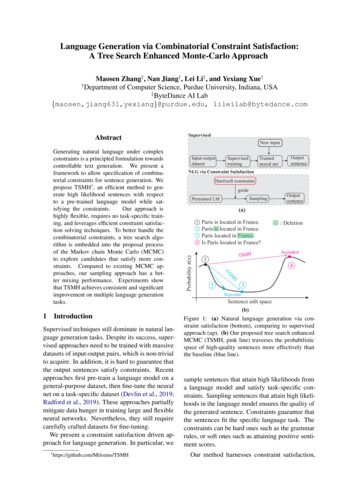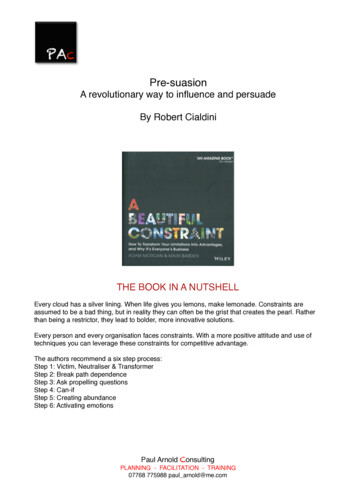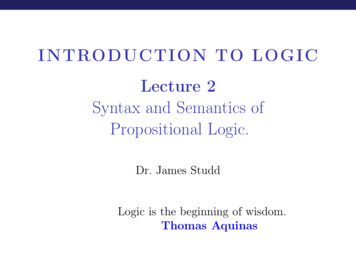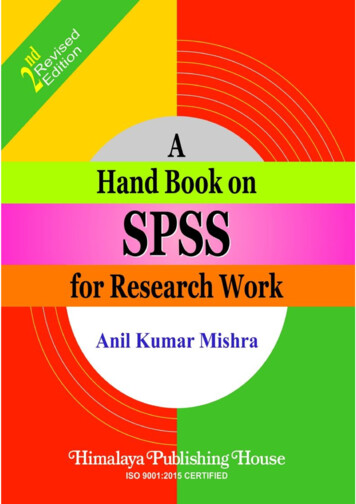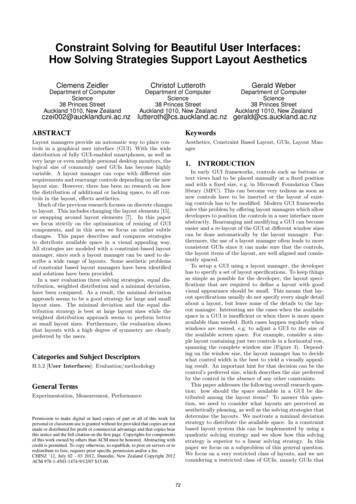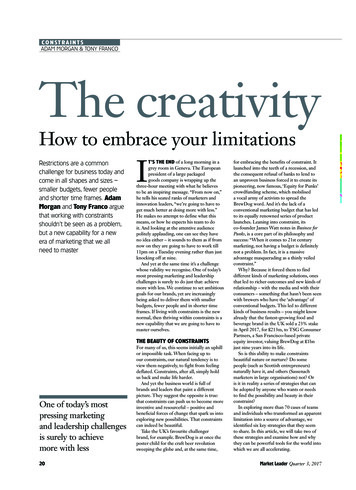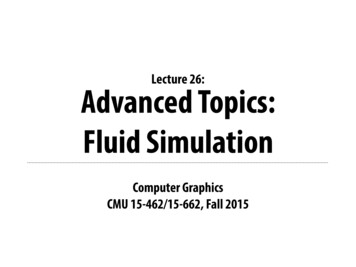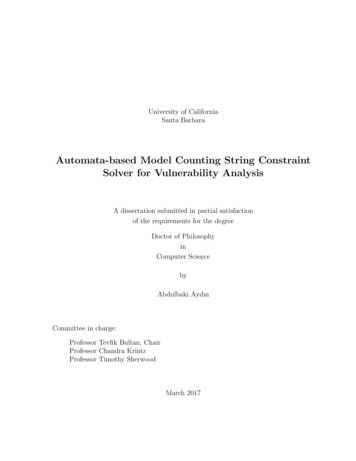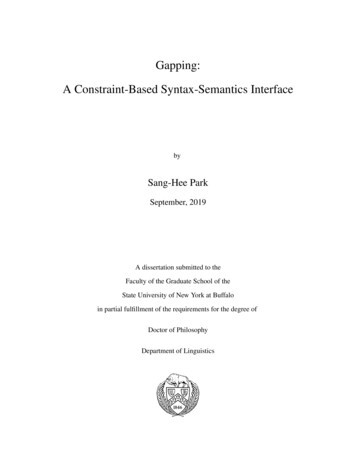
Transcription
Gapping:A Constraint-Based Syntax-Semantics InterfacebySang-Hee ParkSeptember, 2019A dissertation submitted to theFaculty of the Graduate School of theState University of New York at Buffaloin partial fulfillment of the requirements for the degree ofDoctor of PhilosophyDepartment of Linguistics
Copyright bySang-Hee Park2019ii
Approved as to style and content by:Rui P. Chaves, Co-ChairJean-Pierre Koenig, Co-ChairRobert D. Van Valin, Jr., Memberiii
AbstractThis dissertation takes a surface-based and semantic underspecification approach to ellipsisand offers an account of the syntax/semantics of Gapping sentences. These are sentenceswhich consist of a full clause and an elliptical clause (called a gapped clause) that comprises two or more remnant constituents (e.g., John read poems and [Mary novels]). Theapproach taken in this dissertation analyzes gapped clauses as a syntactic unit independent from coordination, and formalizes them as a flat construction that includes all andonly surface constituents. The analysis is based on novel data which provides evidenceabout the occurrence of Gapping in non-coordinate structures, as well as data that is noteasily reconcilable with traditional analyses that postulate underlying full syntactic structures for gapped clauses. Phenomena that were previously attributed to the syntax of aputative underlying structure are explained to follow from constraints on surface structure.Furthermore, the various readings of gapped clauses are captured using semantic underspecification, combined with an independently motivated matching constraint that ensuressemantic parallelism between gapped clauses and their respective source clauses.The analysis of gapped clauses proposed in this dissertation is shown to interact witha general theory of coordination to generate scope ambiguities between the conjunctionand scopal elements in the first conjunct. Often, multiple different derivations are requiredto account for these ambiguities. This dissertation argues against the need for this typeof derivational ambiguity, which is empirically unsupported. Instead, it is proposed thativ
the scopally ambiguous readings of Gapping sentences result from various ways of resolving a single underspecified meaning, associated with a single syntactic analysis. Thisconstraint-based, surface-oriented approach to Gapping accounts for phenomena that wereproblematic in other approaches.v
AcknowledgementsFirst and foremost, I would like to thank my advisors Rui Chaves and Jean-Pierre Koenigfor their continuous support and guidance throughout my PhD.Rui Chaves reignited my interest in ellipsis when I was looking for a topic for mydissertation. Since then he has been infinitely generous with his ideas and advice, and hasalways been quick to respond even to half-baked ideas. Every meeting with him was asource of inspiration and motivation for me to explore new ideas and to push myself togreater depth and clarity of thoughts. His profound knowledge and interest in ellipsis andcoordination, and his support and enthusiasm have been instrumental in carrying out thisresearch. As anyone who writes a dissertation on ellipsis would say, I feel privileged andfortunate to have had him as my advisor.My sincere gratitude also goes to Jean-Pierre Koenig. His ways of approaching andsolving linguistic problems have always impressed me, and his sharp insight and deepknowledge about just any aspect of language and linguistics have tremendously improvedmy work. In every meeting I had with him, he challenged me with probing questions, cameup with solutions to the problems I had, and put me onto the literature I needed – withincredible understanding and patience. I am particularly grateful for his encouragement toexplore more aspects of the semantics of Gapping (using my “cradar”), which shaped thisdissertation in innumerable ways. I would also like to thank him for all those late-nightdiscussions over Skype when we were working in different time zones.vi
I am extremely grateful to my other committee member, Robert Van Valin, too. Ibenefited a lot from interacting with him in his seminars and individual meetings. Hisinterest in my term paper on Gapping and his wonderful suggestions for extending thepaper into future work have been invaluable in developing this dissertation. I also thankhim for reading very carefully through the manuscript and providing helpful feedback andsuggestions in later stages of this research.In addition to my committee members, my dissertation owes a great deal to manyother people. I would like to thank my colleagues Hanno Beck, Erika Bellingham, BradenBrown, Thomas Diaz, Richard Hatcher, Ali Lawson, Aron Marvel and Thomas St. Pierrefor their company, discussions and for their generosity in sharing their intuitions with me.Looking for something that is unspoken in a non-native language might have been muchmore challenging than it was if it had not been for their help. A special thanks is due toHanno Beck for reading and commenting on earlier versions of this work, and also fornumerous conversations over the years. I also thank my other colleagues Yoshihiko Asao,Rebecca Calvetti, Shea Gabriel, Dawei Jin and Hao Sun for their intellectual and emotionalsupport which enriched my experience at UB.I owe a debt of gratitude to my teachers I had at Duksung Women’s University andSeoul National University. I am immensely grateful to Prof. Hee-Cheol Yoon for ignitingmy interest in linguistics during my undergraduate study at Duksung Women’s University.I would also like to thank Prof. Eun-Jung Yoo for her guidance and kind encouragementduring my study at Seoul National University and continuously since then.I had the privilege of presenting earlier versions of this work at a number of conferences. I am especially thankful to the reviewers and audiences at HPSG 25 (The Universityof Tokyo) and at Sinn und Bedeutung 23 (Universitat Autònoma de Barcelona) for theirhelpful feedback. I am also grateful to Kyle Johnson, Frank Richter and Manfred Sailer fortheir comments on earlier versions of parts of this study.vii
My life in Buffalo would not have been so fulfilled without my friends Oksana Yefimchuk and Jung-a Yi who always provided me a home away home. Oksana, I thank you foryour support and friendship all along, and I will truly miss the times I spent with you inBuffalo. Jung-a, thank you for the chats and delicious food, and for your smile that mademy days more beautiful.Last but not least, I am deeply thankful to my family for their support and trust in me.Without their understanding and sacrifice, I could not have pursued, nor finished, this longadventure. Finally, I would like to thank my husband Hyun-Cheol Park for his unfailinglove and support. We met shortly before I started my masters, and he has always been soencouraging and understanding of my academic pursuit, even when we were continentsapart. And now, I am so happy to be there for you, Hyun-Cheol, and I’m excited about thenew life chapter we’re starting together!viii
1.1Phenomenon Overview . . . . . . . . . . . . . . . . . . . . . . . . . . . .21.1.1Basic features of Gapping . . . . . . . . . . . . . . . . . . . . . .31.1.2Gapping and other types of ellipsis . . . . . . . . . . . . . . . . . . 1521.2Main Contributions and Claims . . . . . . . . . . . . . . . . . . . . . . . . 201.3Outline . . . . . . . . . . . . . . . . . . . . . . . . . . . . . . . . . . . . 21On the Distribution of Gapping2.12.223Putative Syntactic Conditions . . . . . . . . . . . . . . . . . . . . . . . . . 242.1.1Gapping and coordination . . . . . . . . . . . . . . . . . . . . . . 242.1.2Embedded Gapping . . . . . . . . . . . . . . . . . . . . . . . . . . 32Consequences for Theories of Gapping . . . . . . . . . . . . . . . . . . . . 382.2.1vP coordination accounts . . . . . . . . . . . . . . . . . . . . . . . 392.2.2Syntactic ambiguity accounts . . . . . . . . . . . . . . . . . . . . 432.2.3Categorial Grammar accounts . . . . . . . . . . . . . . . . . . . . 472.2.4Fragment-based accounts . . . . . . . . . . . . . . . . . . . . . . . 52ix
2.2.52.32.434Interim Summary . . . . . . . . . . . . . . . . . . . . . . . . . . . 56Information Structure . . . . . . . . . . . . . . . . . . . . . . . . . . . . . 572.3.1Focus and QUD . . . . . . . . . . . . . . . . . . . . . . . . . . . . 572.3.2Gapped clauses as answers to an implicit QUD . . . . . . . . . . . 60Summary . . . . . . . . . . . . . . . . . . . . . . . . . . . . . . . . . . . 66Theoretical Background673.1Head-Driven Phrase Structure Grammar . . . . . . . . . . . . . . . . . . . 673.2Semantic underspecification . . . . . . . . . . . . . . . . . . . . . . . . . 723.3Lexical Resource Semantics . . . . . . . . . . . . . . . . . . . . . . . . . 76Gapped Clauses as Fragments904.1Introduction . . . . . . . . . . . . . . . . . . . . . . . . . . . . . . . . . . 914.2Problems for Reductionist Accounts . . . . . . . . . . . . . . . . . . . . . 934.34.44.54.2.1Problems with deletion-based accounts . . . . . . . . . . . . . . . 934.2.2Problems with Johnson’s movement-based analysis . . . . . . . . . 994.2.3Lack of locality effects . . . . . . . . . . . . . . . . . . . . . . . . 101General Approach . . . . . . . . . . . . . . . . . . . . . . . . . . . . . . . 1044.3.1KOS :A theory of discourse . . . . . . . . . . . . . . . . . . . . . . 1054.3.2Fragments in Ginzburg & Sag (2000) . . . . . . . . . . . . . . . . 1064.3.3Syntactic parallelism . . . . . . . . . . . . . . . . . . . . . . . . . 112An HPSG of Gapped Clauses . . . . . . . . . . . . . . . . . . . . . . . . . 1184.4.1Some additional assumptions . . . . . . . . . . . . . . . . . . . . . 1194.4.2A new construction type for gapped clauses: gap-ph . . . . . . . . 121Summary . . . . . . . . . . . . . . . . . . . . . . . . . . . . . . . . . . . 132x
5On the Interaction between Gapping and Scopal Operators5.1The Scope Ambiguity Puzzle . . . . . . . . . . . . . . . . . . . . . . . . . 1345.1.1Basic data . . . . . . . . . . . . . . . . . . . . . . . . . . . . . . . 1365.1.2Constructions that allow for Gapping scope ambiguity . . . . . . . 1395.2Against Syntactic Ambiguity . . . . . . . . . . . . . . . . . . . . . . . . . 1415.3An Account Based on Semantic Underspecification . . . . . . . . . . . . . 1455.45.561335.3.1A type-driven semantics for the Gapping scope ambiguity . . . . . 1465.3.2The semantics of coordination . . . . . . . . . . . . . . . . . . . . 150Gapping: HPSG Syntax-Semantics Interface . . . . . . . . . . . . . . . . . 1525.4.1Coordinate structures . . . . . . . . . . . . . . . . . . . . . . . . . 1525.4.2Scope ambiguity in conjunctive Gapping . . . . . . . . . . . . . . 161Summary . . . . . . . . . . . . . . . . . . . . . . . . . . . . . . . . . . . 171Summary and Conclusion1726.1Summary of Contributions . . . . . . . . . . . . . . . . . . . . . . . . . . 1726.2Future Research . . . . . . . . . . . . . . . . . . . . . . . . . . . . . . . . 173Bibliography176xi
Chapter 1IntroductionAcademic science can sometimes feel like self inflicted torture when that experiment just won’t work. Everybody deals with it in different ways. Some turnto partners, others to alcohol and some just throw their lives at a problem.1This dissertation is concerned with Gapping – elliptical sentences consisting of a gappedclause (exemplified by the underlined string above) and a preceding source clause whichprovides the interpretation for the missing material in the gapped clause. I explore howthe syntax and semantics of gapped clauses interact with each other, and how they interactwith the grammar of coordination and other complex constructions to generate Gappingsentences.A great deal of research has been devoted to the topic of Gapping in generative grammar. Starting with Ross (1970) traditional analyses assumed that Gapping sentences derivefrom conjoined full sentences via a reduction process (deletion or movement operation).One persistent point of criticism has been that the alleged parallel between a gapped clauseand its full-sentence counterpart does not always hold. Moreover, more recent research hasshown that the syntactic relationship between gapped clauses and their respective ents-academics-deal-stress-anxiety-depression/1
2Chapter 1. Introductionclauses is not restricted to coordination as previously assumed. As a consequence, effortshave been made to provide a proper analysis of the phenomenon by characterizing gappedclauses as fragments – sequences of words which lack a finite verb but nonetheless forma clause on their own (Sag et al. 1985, Culicover & Jackendoff 2005, Abeillé et al. 2014,among others). As I will show in this work, however, none of these efforts is entirely satisfactory in capturing all the generalizations of Gapping data. There are still major ongoingissues as to how the meanings of gapped clauses are best accounted for and how thosemeanings interact with the semantics of coordination to allow for various scopal readings.This dissertation presents an analysis of Gapping which is able to account for a number of phenomena that have been problematic for previous analyses. My approach is basedon prior fragment-based approaches to Gapping (Sag et al. 1985, Culicover & Jackendoff2005, Abeillé et al. 2014), but it modifies and extends that research in several ways. In particular, the analysis proposed in this work integrates questions under discussion (Ginzburg1996 et seq.; Roberts 1996/2012) to capture the context-dependence of gapped clauses (cf.Reich 2007) and utilizes semantic underspecification techniques to represent the semanticsof gapped clauses as well as its interaction with coordination. The result is a constraintbased constructivist analysis of the syntax/semantics of Gapping in which gapped clausesinteract with coordination and other complex structures. The analysis is developed in theframework of Head-Driven Phrase Structure Grammar (HPSG), combined with the underspecified semantic formalism Lexical Resource Semantics (LRS) (Richter & Sailer 2004).Nothing crucial hinges on these choices, however.1.1Phenomenon OverviewThis introductory section lays out the basic characteristics of Gapping. It also defines whatGapping is not, by describing related phenomena that will not be dealt with in this work.
1.1 Phenomenon Overview1.1.13Basic features of GappingGapping involves two clauses that are similar in some sense. The first clause is complete(called the source clause) while the second clause is missing a finite verb and optionallyother material (called the gapped clause). In (1) the string Chris played tennis constitutesthe source clause and the string Bill volleyball the gapped clause.2 The overt constituentsin the gapped clause are called the remnants and the source clause elements which correspond to the remnants are called the correlates; what is not a correlate in the source is theantecedent (of missing material).3(1)[Chris played tennis]source and [Bill volleyball]gapped clauseRemnants Bill, volleyballCorrelates Chris, tennisAntecedent played(1) is interpreted as meaning that both Chris and Bill played some sports, each adifferent sport: Chris played tennis and Bill played volleyball. But how is this completeinterpretation possible even though there is material missing in the gapped clause? Andwhat qualifies as an appropriate source clause and how does it relate to the gapped clause?These questions are not new, and numerous answers have been offered in the literature frommany different theoretical perspectives. Yet, many aspects of Gapping remain unaccountedfor. This dissertation constitutes an attempt at filling in this research gap.2All the data in this work has been validated by native speakers. Throughout this dissertation, I generallyuse the term ‘acceptability’ rather than ‘grammaticality’, in order to avoid the issue of whether the judgmentsdiscussed are the result of grammatical or extra-grammatical factors.3Gapping sentences are usually pronounced with a particular intonation contour: the default intonationinvolves a rising pitch accent on the first remnant and its correlate, and a falling accent on the second remnantand its correlate (Oehrle 1987; Carlson 2001; Féry & Hartmann 2005; Winkler 2005; Repp 2009). See (i)from Carlson (2001:15) for an illustration.(i)B OB insulted the guests during DINner and S AM insulted the guests during the DANCE.L*HH* L-H%L*HH* L-L%However, these accents are not obligatory and their precise shape can vary depending on the context.
4Chapter 1. IntroductionTo get started, I introduce below some key features of Gapping that the present workaims to account for, with some background on the issues they pose.What makes a good gapped clause? As illustrated by (1) a well-formed gappedclause consists of two major components: two (or more) remnants and some missing material. In (1) what appears to be missing in the gapped clause corresponds to the finite verbin the source clause. But other material may additionally go missing along with the finiteverb; see (2a-b) for example.(2)a.Mary enjoys reading stories to her kids and Sally enjoys reading stories to herstudents.b.Kim wants Hillary to win and John wants Trump to win.In (2a) the material missing in the gapped clause consists of a finite verb as well as agerundive verb and its direct object; in (2b) the missing material corresponds to two noncontiguous strings. Moreover, as the examples in (3) show, what is missing in a gappedclause may even cross a finite-clause boundary.(3)a.This doctor said I should eat more tuna fish, and that doctor said I should eatmore salmon.b.Robin believes that everyone pays attention to you when you speak French,and Leslie believes that everyone pays attention to you when you speak German.((3a) is due to Pesetsky 1982; (3b) is due to Culicover & Jackendoff 2005)In fact, virtually any string of elements can go missing in a gapped clause so long as thefinite verb is missing as well. This property – i.e., the absence of a restriction on what canbe missing additional to the finite verb – constitutes a major difference from other typesof ellipsis such as VP-ellipsis and Pseudogapping, where what is missing is restricted to
1.1 Phenomenon Overview5material within the VP:4(4)a.VP-ellipsis:Robin might read the magazine, but Leslie won’t.b. Pseudogapping:Robin might read the magazine, but she won’t the novel.A successful instance of Gapping requires that the missing material in the gappedclause be sufficiently identical to the antecedent in the source clause. Two different viewshave been taken on this matter: one view suggests that the relevant notion is formal identity(Sag 1976; Hankamer 1979; Potter et al. 2017) while another view suggests that the identityis semantic in nature (Coppock 2001; Culicover & Jackendoff 2005; Abeillé et al. 2014).The evidence seems mixed. In favor of the semantic identity are permitted mismatches.For example, Wilder (1994) and others noted that the alleged verb in the ellipsis site andthe antecedent may differ in their agreement specifications:(5)They live in London and she lives in Berlin.(Wilder 1994:308)Tense specifications are usually required to match, as in (6), but mismatches are permittedin some cases, as in (7).(6) #Kim arrived yesterday and Sue will arrive tomorrow.(7)The Greeks believed in multiple gods and we believe in only one.(Data and observation are due to Jean-Pierre Koenig, p.c.)While this data suggests that the semantic identity view is correct, there is also data whichhas traditionally been argued to support the formal identity view. See §4.3.3 for examplesand discussion.4In this dissertation, I use the term ellipsis as a descriptive term, without advocating the view that what ismissing in ellipsis is present at some level of syntactic representation.
6Chapter 1. IntroductionLet us next consider the defining properties of the remnants. Traditionally, it wasargued that the number of remnants in a gapped clause may not exceed two. This claim isbased on examples such as the one in (8) (Hankamer 1973; Stillings 1975; Pesetsky 1982).(8)*John persuaded Bill to see a movie and Harry Mary a TV show.(Pesetsky 1982:657, ex. (159), his judgment)However, it is unlikely that the oddness of (8) is due to a grammatical constraint on thenumber of remnants. Sag (1976:196-7) and Culicover & Jackendoff (2005:273), amongothers, reported that speakers find examples such as (9) to be fully acceptable.(9)Betsy dances with a parasol in the living room on Fridays and Peter with a meatclever in the bar on Saturday nights.(Sag 1976:278)The gapped clause in (9) contains four remnants – [Peter], [with a meat clever], [in the bar],and [on Saturday nights] – without inducing unacceptability. Given this data, it seems moreplausible to assume that the oddness of (8) is due to processing difficulties associated withthe recovery of the missing verb and the (semantic) roles of bare remnants, as Culicover &Jackendoff (2005:273) presume. I will not pursue this matter any further in this work.Concerning the syntax of the remnants, some authors argued that well-formed remnants must be a ‘Major Constituent’: to simplify, a Major Constituent is a constituent whichis a dependent of some verbal projection (Hankamer 1971, 1973; McCawley 1988; Abeilléet al. 2014). The intuition behind this argument is that remnants cannot be deeply embedded in the (reconstructed) gapped clause without inducing ungrammaticality. Compare forinstance the second remnants in the following examples:(10)a. ?George became ashamed of the Washington family’s past and Martha proud.( Martha became proud of the Washington family’s past)
1.1 Phenomenon Overviewb.7George became ashamed of the Washington family’s past and Martha proudof it. ( Martha became proud of it)(McCawley 1988:287)Clearly, proud is more deeply embedded in (10a) than proud of it is in (10b). The notionof Major Constituent permits a simple characterization of the difference between thosetwo remnants: proud does not qualify as a Major Constituent whereas proud of it does.The contrast in acceptability between (10a) and (10b) can then be said to follow from theassumption that only those elements that qualify as a Major Constituent make well-formedremnants.However, this argument is flawed as it is based on a faulty empirical assumption. Awider set of data suggests that the presumed notion of Major Constituent is too restrictiveto capture legitimate remnants. Consider for instance the examples in (11) from Hudson(1989).(11)a.John thought about Jane and Bill Betsy.b.Fred sat on a chair, Mary a stool, and Bill a bench.In these examples the second remnants appear as the complement of a preposition, whichdoes not, strictly speaking, qualify as a Major Constituent. The contextualizing questions in(12) below are provided for readers to whom the acceptability of (11a-b) is not immediatelyobvious. Note that the fact that the acceptability of cases such as (11) improves in thecontext of a suitable question was noted previously in Steedman (1990).(12)a.Which boy thought about which girl?b.Which student sat on what kind of chair?Consider also the example in (13) from Huddleston & Pullum (2002:1139). The first remnant in this example, of Pat, is not a Major Constituent but a dependent of a noun whosemaximal projection is a Major Constituent.
8Chapter 1. Introduction(13)His criticisms of Kim were inaccurate and, of Pat irrelevant.( his criticisms of Pat were irrelevant)In this work I propose to explain the above examples by assuming that only phrasalconstituents may serve as well-formed remnants in Gapping and fragments. There is asense in which what survives Gapping constitutes a reduced ‘answer’ to a wh-question, asone can see from (11)-(12) above. Given that phrasal constituents are acceptable as suchreduced answers but sub-phrasal constituents generally are not, it does not seem implausible to suppose that, due to their answer-like function, there is a grammatical constraintthat remnants are restricted to phrasal constituents (cf. Schlangen 2003:210: fn. 16). Themarginality of (10a) can then be regarded as a violation of this functionally motivated constraint.5Since Kuno (1976) and Sag (1976:287), it has often been observed that the remnantsin Gapping must contrast in some sense with their respective correlates in the source. Therelevant notion of contrast comprises two distinct requirements: disjoint reference and parallelism. Data such as (14)-(15) can be explained in light of these notions: (14) shows thata given remnant must not be referentially identical to its correlate, and (15) shows that aremnant and its correlate must be parallel in the sense that they are semantically comparable.(14)(15)*Johnx eats peas and Johnx /hex rice.(Kuno 1976:309)a. *Tom complains about the work load and Bill incessantly.b.Tom complains about the work load and Bill about the pay.(Hendriks 1991:44)5Some speakers tend to accept sub-phrasal remnants such as the one in (i) from Park (2016) (small capsindicates focal accent).(i)Many famous LINGUISTS have been D UTCH and HISTORIANS G REEK.( many famous historians have been Greek)For these speakers the constraint against sub-phrasal remnants is optional.
1.1 Phenomenon Overview9In other words, each remnant and its correlate must form suitable alternatives with respect to each other in the sense of Rooth (1992), more specifically, mentioned alternativesrather than merely evoked ones. Explicitly mentioned alternatives are sometimes calledcontrastive focus (Jackendoff 1972; Rooth 1992; Krifka 1992; É. Kiss 1998; Vallduvı́ &Vilkuna 1998; Molnár 2002; Selkirk 2008). Section §2.3 provides a discussion on the roleof contrastive focus in Gapping; for discussion of the prosodic effects of contrastive focus in Gapping, see Carlson (2001), Féry & Hartmann (2005) and Winkler (2005), amongothers.To summarize the discussion so far, I have shown that a well-formed gapped clausecontains (i) some missing material which includes a finite verb and optionally any dependent of that verb and (ii) virtually an unbounded number of remnant phrases that arecontrastive foci. The grammar imposes no further constraint on the remnants and missing material as well as how these are ‘matched’ with the source clause elements. As aconsequence, ambiguity may arise because there can be more than one way to realize contrastive focus through such matches. As an illustration, consider the following examplefrom Coppock (2001:22):(16)John said he wants caviar for dinner, and Mary beans.In (16) Mary can bear a contrastive focus with respect to either John or he, and this ambiguity in the way contrastive focus is set up results in an ambiguity in the interpretation ofthe missing material. The two possible construals for (16) are indicated below:(17)a.J OHN said he wants CAVIAR for dinner and M ARY said she wants BEANS fordinner.b.John said HE wants CAVIAR for dinner and M ARY wants BEANS for dinner.One final point to mention about gapped clauses concerns their sensitivity to complementizers. Lasnik & Saito (1992), Chaves (2005) and others observed that embedding
10Chapter 1. Introductiona gapped clause under a complementizer results in ungrammaticality:(18)I think that John saw Bill, and (*that) Mary Susan.(Chaves 2005:208, ex. (29))However, it seems unclear whether the unacceptability of (18) is the result of a syntacticconstraint. The speakers I consulted report that there is a contrast in acceptability betweenGapping sentences with the complementizer that and those with the complementizer if : theformer are completely out but the latter are marginally acceptable.6 Compare for instancethe example in (18) with the following example:(19) ?I wonder if John will bring more dessert, and if Mary more wine.Since that and if are uniform in their syntax – i.e., they are both complementizers – the contrast in acceptability between (18) and (19) cannot be attributed to a syntactic constraint.On the other hand, these complementizers have different semantic properties, and one important difference lies in their (non-)factivity. In §2.1.2, I will discuss another type of datawhich shows that Gapping is generally incompatible with a factive environment.Having discussed the basic features of gapped clauses, I will next move on to aspectsof Gapping that pertain to the the overall Gapping construction.No implicit source. One familiar criterion for classifying ellipsis and fragments isthe nature of the antecedent. A classification due to Hankamer & Sag (1976) suggestsa distinction between surface and deep (elliptical) anaphors. Surface anaphors require asource that is linguistically present whereas deep anaphors can be rendered felicitous bya non-linguistic, implicit source. Similarly, Schlangen (2003) maintains a distinction between fragments whose interpretation can be retrieved from a prior utterance (fragmentsof type resolution-via-identity) and those whose interpretation requires inferences basedon non-linguistic information (fragments of type resolution-via-inference). According to6This observation is specific to English; it remains to be seen whether the same observation also holds forGapping in other languages.
1.1 Phenomenon Overview11Schlangen’s classification, Gapping is a resolution-via-identity type fragment because itrequires a linguistic source:(20)[Hankamer produces an orange, proceeds to peel it, and just as Sag produces anapple, says:] #And Ivan, an apple.(Hankamer & Sag 1976:410)No backwards Gapping. Gapping is sensitive to ordering in that the source clausemust be introduced prior to the gapped clause (Wilder 1994:305-6, Coppock 2001). Thefollowing example is an attempt at producing ‘backwards Gapping’:(21) *Chris tennis and Bill played volleyball.
A Constraint-Based Syntax-Semantics Interface by Sang-Hee Park September, 2019 A dissertation submitted to the . my days more beautiful. Last but not least, I am deeply thankful to my family for their support and trust in me. Without their understanding and sacrifice, I could not have pursued, nor finished, this long .
